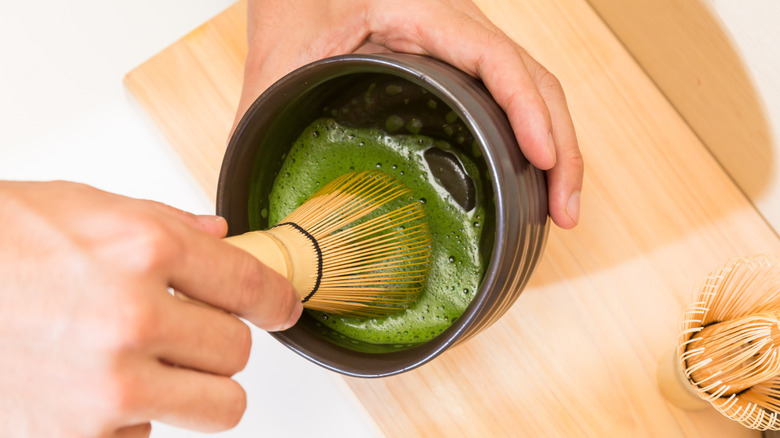You're Probably Making Matcha Wrong: Common Mistakes To Avoid
If you love grabbing a matcha latte at the coffee shop but find it tricky to prepare beverages with the vibrant green powder at home, you're not alone. It's all too easy to create a drink that's flat rather than frothy, or bitter instead of balanced. To find out some of the common mistakes people make with matcha and how to avoid them, Food Republic consulted Jee Choe, a coffee and tea sommelier and the creator of Oh, How Civilized.
It's not enough to just mix matcha with hot water and hope for the best — you need to use the right techniques to get good results. Choe's tips cover everything from how to correctly combine the powder for a smoother result to the temperature of the water to use for the best taste when making a good cup of matcha, whether it's to be consumed the traditional way or in a latte.
Matcha comes from the powdered whole leaves of the Camellia sinensis plant and gets its gorgeous hue from being covered in bamboo mats as it grows, increasing the amount of chlorophyll. As well as looking appealing and tasting great, it also has a host of benefits – it may reduce stress, aid bone health, and increase mental clarity. And once you follow Choe's advice, you'll be able to whisk up a cup of the prized drink at home like a pro.
Don't use water that's too hot
Just as there's an ideal water temperature for brewing coffee, it's just as important when making matcha. "Don't use boiling hot water to make matcha since it can make the tea taste bitter," expert Jee Choe explained. The reason for this is that boiling water can burn the delicate powder, dulling its color as well as changing its flavor. "Instead, use water that has come to a simmer," Choe advised.
The best temperature for brewing matcha is a maximum of 176 degrees Fahrenheit. If you've brought the water to a boil, pour it into a cup and let it cool for a minute or so until it reaches that temperature before pouring it into the tea powder. Alternatively, you could add a splash of cold water to boiling water to lower the heat. If you find the flavor of the drink too sharp or harsh, using water that's cooler than 176 degrees can result in a milder-tasting cup — try 158 degrees.
Don't stir it in a circular motion
Once you've added the hot water to your matcha powder, you need to whisk it to get rid of lumps and create a frothy consistency. But it's not quite as simple as just stirring it. "Matcha is a finely ground leaf, so it doesn't dissolve in water," explained Jee Choe. "What it actually does is suspend in water, so to make matcha properly, you have to create enough friction in the water for the suspension to happen."
While it helps to use a bamboo (not metal) whisk when making matcha, the technique is also key. "One of the mistakes many people make is to stir or move the whisk in a circular motion, which doesn't create enough friction," Choe noted. Try making an "m" shape as you whisk instead — it will take around 20 seconds to get a frothy result. To prevent any lumps, it's also a good idea to sift the powder before you add the water.
Make a paste for superior matcha lattes
If you want to add milk to make a matcha latte, there's an important step to follow first. "If you're new to making matcha at home, make a paste with matcha and a couple of tablespoons of hot water," explained Jee Choe. "Making the matcha paste will make it easier to mix into milk to make matcha lattes." Either use a whisk or a frother to mix hot milk with the paste, but don't use boiling milk as it can curdle.
If you're using plant milk, it's worth noting that barista blend oat milk is the best non-dairy milk to use for frothing. Add a teaspoon or two of honey, some maple syrup, or a little granulated sugar to the paste if you find the drink too bitter. Sprinkling some nutmeg or cinnamon on top of the finished drink will add a warm balanced flavor.




